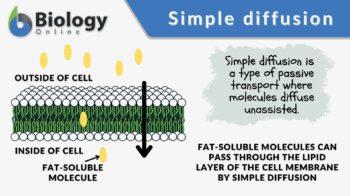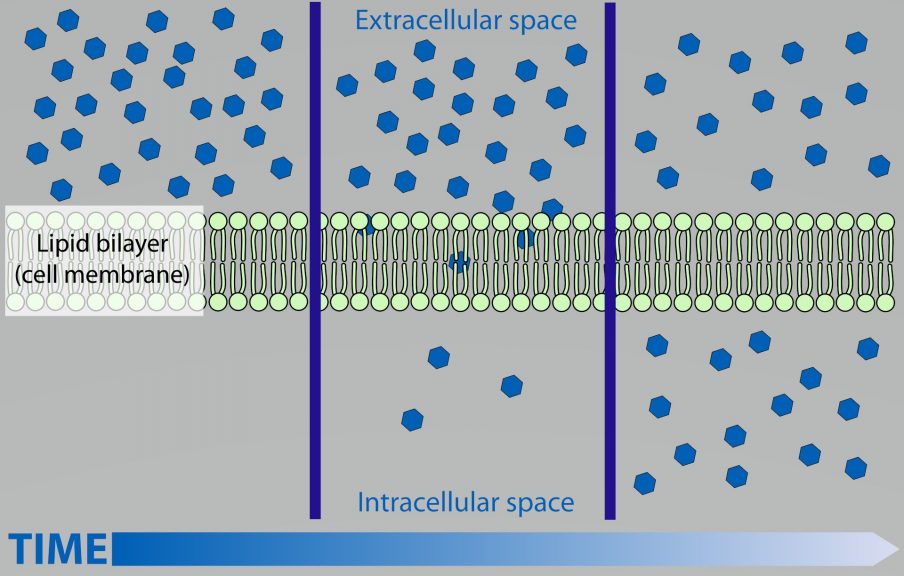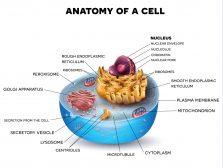
Simple diffusion
n., plural: simple diffusions
[ˈsɪmpəl dɪˈfjuːʒən]
Definition: an unaided form of diffusion
Table of Contents
Diffusion is essential in the anatomy and physiology of a living thing, especially with regard to homeostasis. It is one of the ways by which the body employs so as to regulate the concentration of substances. Without it, biological molecules, ions, and other compounds will not move down their concentration gradients readily and with ease.
Thus, the ideal or optimal concentrations of such molecules may not be promptly achieved in the body. Thus, this type of diffusion is pivotal in maintaining equilibrium. The process entails the transport of molecules and substances relatively with ease and without the need for ATP expenditure (as opposed to active transport).
Simple Diffusion Definition
What is simple diffusion? In biology, a simple diffusion is a form of diffusion that does not require the assistance of membrane proteins. In essence, the particle or substance moves from higher to lower concentration. However, its movement does not need a membrane protein that will help substances to move downhill.
In other science disciplines, such as physics and chemistry, diffusion is defined basically as the “spreading out” of the objects from the initial area of higher concentration. In a biological system, the same principle applies but the process involves a selectively-permeable biological membrane.
Etymology: diffusion came from the Latin diffusionem, diffusio, meaning “a pouring forth”.
Synonyms: free diffusion.
Compare: facilitated diffusion

Features
Simple diffusion is one of the major types of passive transport. The others are facilitated diffusion (also called facilitated transport), filtration, and osmosis. All of them are characterized by a downhill movement — that is, a movement from an area of high concentration to an area of low concentration.
By contrast, active transport entails an uphill movement of substances, i.e. from an area of low concentration to an area of high concentration. And since the movement is downhill or “passive”, chemical energy (ATP) is not needed for the process to proceed.
This is distinct from the other types of membrane transport in being independent. This means substances do not use any membrane proteins to move from one area to another. By contrast, facilitated diffusion requires carrier protein and channel proteins whereas osmosis requires aquaporins (also called water channels) for molecules to move into and out of the cells.
Solutes are the entities that move as opposed to osmosis, which is based upon the movement of the solvent (e.g. water) across the plasma membrane.
Process of Simple Diffusion
In biological systems, ATP (a chemical form of energy) does not directly drive simple diffusion. Similar to other mechanisms, the energy that fuels simple diffusion is kinetic energy and concentration gradient. In simple diffusion, the molecules struck each other. As a result, molecules are in random constant motion.
The collision of particles is called pedesis. When an area is concentrated, the molecules tend to be compacted. The motion is reduced as well. Thus, when a larger space becomes available, the molecules tend to move towards an area with a larger space.
Another requirement is a concentration difference, also referred to as the concentration gradient, which pertains to the difference in concentration between two areas. The movement of molecules will continue between the two areas as long as there is a concentration gradient.
Difference between Simple Diffusion and Facilitated Diffusion
The downhill movements of solutes particularly define passive diffusion. Both simple and facilitated diffusion mechanisms are types of passive transport where solute molecules move from a region of higher to a region of lower concentration.
The difference between them is that in simple diffusion the molecules move without the aid of membrane proteins whereas in facilitated diffusion it helps the molecules move downhill. The table below is shown to describe the similarities and differences between the two.
Watch this vid about diffusion:
Table 1: Simple vs Facilitated Diffusion |
|
|---|---|
| Simple Diffusion | Facilitated Diffusion |
| Simple diffusion (definition in biology): a type of passive transport where molecules diffuse unassisted | Facilitated diffusion (definition in biology): a type of passive transport where molecules diffuse with assistance from membrane proteins |
| Concentration gradient (a form of potential energy)1 results in the movement of molecules from an area of higher concentration to an area of lower concentration | |
| Apart from a concentration gradient, kinetic energy or natural entropy of molecules further fuels the process. | |
| Example of simple diffusion: passive transport of small nonpolar molecules across the plasma membrane | Example of facilitated diffusion: passive transport of glucose and ions into and out of the cell |
Simple Diffusion Examples
In biological systems, simple diffusion is exemplified by the simple transport of molecules at the cellular level. The bilipid membrane feature of the plasma membrane (or cell membrane) prevents the entry and exit of all molecules. Not all can diffuse freely via simple diffusion.
A specific form of a molecule that can do so is one that is small and nonpolar, like oxygen, carbon dioxide, and ethanol. (Ref. 2) These molecules can diffuse easily across the membrane. They are hydrophobic and therefore can easily diffuse through the hydrophobic lipid bilayer of the cell membrane.
Simple diffusion also occurs within the cell. The porous outer membrane of the mitochondria (in animal and plant cells) and chloroplasts (in plants) allows the easy passage of small molecules. (Ref. 3)
Take the Simple Diffusion Biology Quiz!
Further Reading
References
- Bartee, L., Shriner, W., & Creech, C. (2017). Passive Transport: Diffusion. Pressbooks.Pub; Open Oregon Educational Resources. https://openoregon.pressbooks.pub/mhccmajorsbio/chapter/passive-transport-diffusion/
- Nishiura, J. Retrieved from ://academic.brooklyn.cuny.edu/biology/bio4fv/page/simple.htm.
- Cell Membranes | Learn Science at Scitable. (2010). Nature.Com. https://www.nature.com/scitable/topicpage/cell-membranes-14052567/
©BiologyOnline. Content provided and moderated by BiologyOnline Editors.

